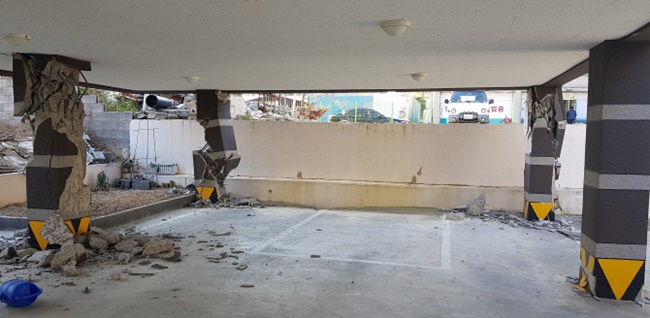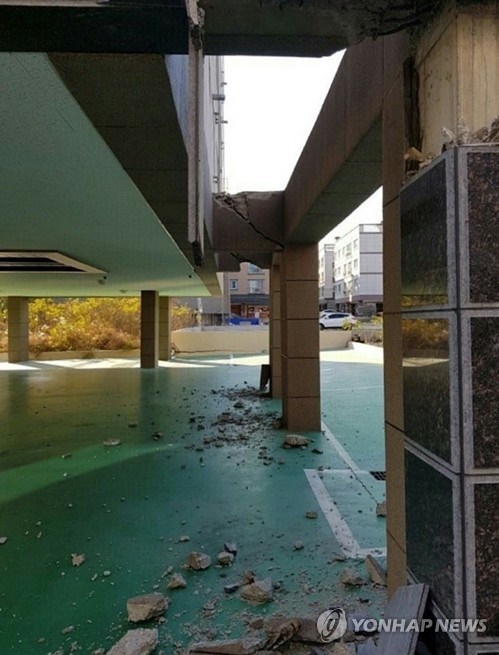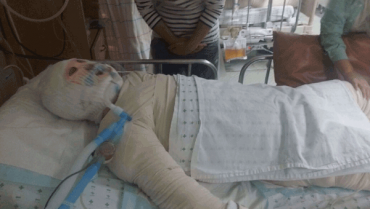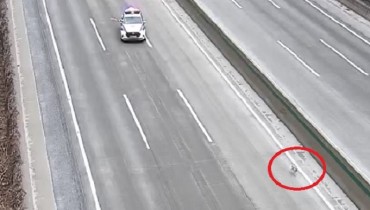
Safety concerns are growing over residential buildings supported by pillars on the first floor, also known as pilotis, as one of the most popular architectural styles among construction companies has been proven particularly vulnerable to earthquakes. (Image: Yonhap)
BUSAN, Nov. 17 (Korea Bizwire) – Piloti-type buildings in South Korea are in the spotlight over their vulnerability to earthquakes in the wake of the 5.4-magnitude temblor in Pohang on Wednesday.
Safety concerns are growing over residential buildings supported by pillars on the first floor, also known as pilotis, as one of the most popular architectural styles among construction companies has been proven particularly vulnerable to earthquakes.
Piloti-type buildings, which are commonly found in South Korea, are supported by pillars, leaving room for a parking lot or a convenience store on the first floor, which is typically unpopular among residents over security concerns.
Against this backdrop, piloti buildings have enjoyed popularity from both residents and building companies over their use of space and simple construction up until recently when pictures of damaged piloti-type buildings in Pohang began surfacing on the internet, sending alarming signs to experts and millions of residents.
Without any walls on the ground level, the weight of the building is supported by four to eight pillars, leaving the structure vulnerable to both vertical and horizontal earthquake movement.

Piloti-type buildings in South Korea are in the spotlight over their vulnerability to earthquakes in the wake of the 5.4-magnitude temblor in Pohang on Wednesday. (Image: Yonhap)
Oh Sang-hoon, a professor of architectural engineering at Pusan National University, said that when an earthquake hit Kumamoto Prefecture last April, nearly 80 to 90 percent of the damaged ferroconcrete buildings in the downtown area were piloti-type.
Piloti-type buildings, despite being among the most vulnerable to earthquakes, began gaining popularity around 2002 when stricter parking rules in residential areas were introduced, as buildings supported by pillars often use the space on the first floor as a parking lot.
Oh noted that legal loopholes allowed the widespread construction of piloti buildings without earthquakes in mind, despite regulations put into law in 2015 requiring three-story or taller buildings to be built with earthquake-resistant properties.
“Despite the regulations on buildings over three stories, proper inspections are not taking place. Currently, the plans for buildings under seven stories are checked not by structural engineers but design experts, and it’s difficult for them to measure the structural safety of piloti buildings based on seismic loading,” Oh said, while arguing that architectural engineers need to do the job instead.

Piloti-type buildings, despite being among the most vulnerable to earthquakes, began gaining popularity around 2002 when stricter parking rules in residential areas were introduced, as buildings supported by pillars often use the space on the first floor as a parking lot. (Image: Yonhap)
Though Oh says putting up walls or braced steel frames can help ensure the structural safety of piloti-type buildings, he says the increased financial burden and restricted use of the first floor will discourage construction companies from employing these measures.
Hyunsu Yim (hyunsu@koreabizwire.com)






